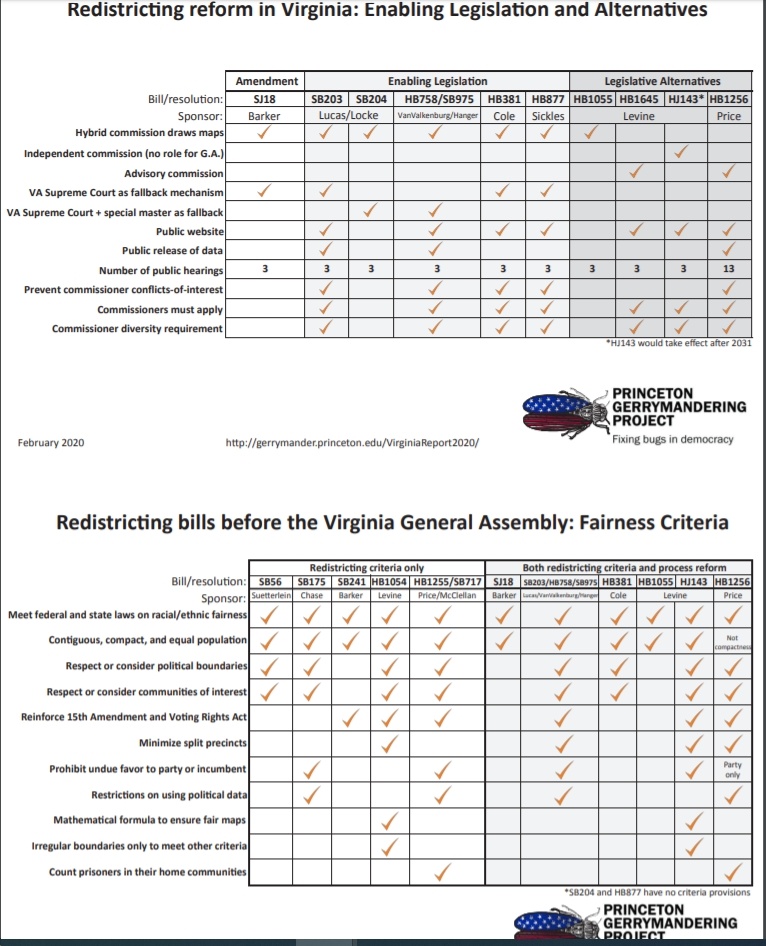From Chris Ambrose, who has been a leader in the fight for strong, anti-gerrymandering, redistricting legislation, but who has not been a fan of the proposed redistricting *amendment* to the Virginia constitution (for the reasons he outlined here).
This nonpartisan comparison of the redistricting options before the General Assembly makes clear how bad the amendment is. It is dead last. Note the only two “Fairness Criteria” it meets on the second page are Compactness/Contiguous/equal population and meets federal and state civil rights laws.
That is pretty appalling and what the critics have been pointing out. Every bill meets those criteria and for good reason: They are required by the Virginia and US Constitutions and by state and federal law. Unfortunately, the amendment has NO criteria that restricts gerrymandering.
For more discussion of the Princeton Gerrymandering Project’s analysis, see here. Key points (bolding added by me for emphasis):
- “By itself, the amendment is not that strong. To fix that, legislators proposed a slew of “enabling legislation,” i.e. legislation to be implemented specifically if the constitutional amendment is approved by voters. The enabling legislation that passed [Tuesday], SB203 (Lucas/Locke, 13-2), would add commissioner selection requirements, as well as public input and transparency requirements, including the public release of redistricting data. The inclusion of these additions will increase SJ18’s effectiveness.”
- “Additionally, SB203 also addresses an objection made by Democrats. Opponents of the amendment noted that a deadlock gets turned to the state Supreme Court, and claimed this was a problem, because such an occurrence might give the Court free rein. SB203 says that if a deadlock occurs, legislative leaders will send the names of candidate Special Masters to the Court. In turn, the Court will pick two masters, one from each party. This may make the bill more defensible to some lawmakers.”
- “In addition, SB203 contains fairness criteria. These rules would govern the district map that the Commission would produce. Such criteria would include Voting Rights Act language, community of interest protections, counting prisoners in their home communities, and a prohibition of partisanship on a statewide basis (similar to tests proposed by PGP). Most reformers agree it is important to establish criteria to create rules about how districts should be drawn. Therefore, establishing fairness criteria is an important step in good reform.”
- “The second bill that passed yesterday, SB717 (McClellan, 9-6), contains the same fairness criteria as SB203. However, SB717 is standalone legislation, meaning that it doesn’t require the constitutional amendment in order to have force. Also, unlike SB203, this bill passed on a party line vote, creating concern that these criteria will be revisited and amended sometime before a final vote is held. Even though these bills have similar fairness criteria, it is possible that these criteria may change before they reach the Senate floor.”
- “There are many steps ahead, but early indications are that redistricting reform is alive in the Old Dominion.”















![Video: Rep. James Walkinshaw (D-VA11) on “Terrible, Horrific” Shooting of Two National Guard Members in DC, Says “it’s incumbent upon the [Trump] administration to lay out a clear plan to ensure their protection”](https://bluevirginia.us/wp-content/uploads/2025/11/walkinshawnationaguard1-100x75.jpg)
